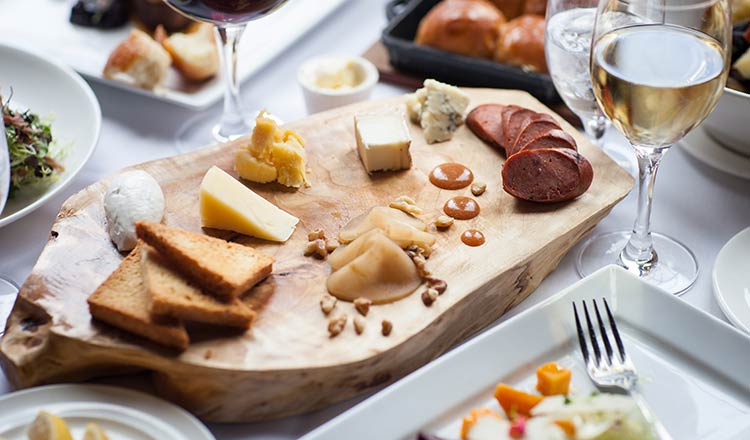As a last course, a composed plate of one cheese with one or more accompaniments can be a nice alternative to a sweet dessert. And, of course, nothing makes for a perfect party more than a cheese board for grazing.
A variety of approaches can be taken when creating a cheese plate, but the key is finding a balance of flavors that, when combined, enhance the overall taste experience. Think about your chosen cheese’s acidity or bitterness, sweetness or saltiness, body, richness, and texture, and then pair it with other foods with complementary attributes. Three types of foods have a natural affinity for cheese and make excellent accompaniments: wine and beer, bread and crackers, and fruit. A few other traditional pairings are: balsamic vinegar, honey, olives, and nuts.
When the cheese plate is one course in a larger meal, a guest should be served no more than 5 ounces of cheese. Remember that cheese is a rich protein, and you don’t want to overwhelm your guests.
Neatness and visual appeal are essential to a composed cheese plate. Keep cheeses whole as long as possible, and when you do cut them, the individual portions should refer back to the shape of the whole cheese’s shape; for instance, wheels should be cut into pie-shaped wedges, pyramids into triangles, and logs into rounds. There are a couple exceptions to this rule: very hard cheeses, especially those of the grana style, will need to be served as irregular chunks chiseled off whole, and the softest of cheeses are impossible to cut with a knife, so you’ll need to use a spoon or spreader.
Because cheese is a living food, it is critical to store it at the proper temperature. Cheese should never be allowed to sit out at room temperature for extended periods of time. Always keep cheeses covered or wrapped in the refrigerator. Waxed paper or aluminum foil work well, because they allow the cheese to breathe but not to dry out. In general, blue cheeses should be kept separate from other cheeses, especially bloomy rinds, and at a colder temperature to keep the interior mold from spreading too much. Never freeze cheese—it will destroy the texture.
Before serving, every cheese should be aromatized, or allowed to come to room temperature, to bring out the fullest flavor of the cheese.


